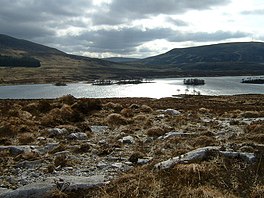Freshwater loch
| Loch Awe | |
|---|---|
 Loch Awe Trees have flourished on the islands, safe from grazing deer. Loch Awe Trees have flourished on the islands, safe from grazing deer. | |
 | |
| Location | NC24561530 |
| Coordinates | 58°05′29″N 4°58′40″W / 58.09130096°N 4.97789574°W / 58.09130096; -4.97789574 |
| Type | freshwater loch |
| Primary inflows | Unnamed burn that flows from Loch Na Gruagaich into the northern end of Loch Awe. |
| Primary outflows | River Loanan flows north from Loch Awe and drains into Loch Assynt |
| Max. length | 1.28 km (0.80 mi) |
| Max. width | 0.48 km (0.30 mi) |
| Surface area | 31 ha (77 acres) |
| Average depth | 4.92126 ft (1.50000 m) |
| Max. depth | 6.88976 ft (2.10000 m) |
| Water volume | 16,573,596.9 cu ft (469,312.00 m) |
| Shore length | 4 km (2.5 mi) |
| Surface elevation | 154 m (505 ft) |
| Max. temperature | 53.5 °F (11.9 °C) |
| Min. temperature | 3.5 °F (−15.8 °C) |
| Islands | 8 |
| Shore length is not a well-defined measure. | |
Loch Awe is a small loch, located 4 miles south of Loch Assynt and next to the village of Ledmore, within the Assynt area of Sutherland, Scotland. The loch is located in an area along with neighbouring Coigach, as the Assynt-Coigach National Scenic Area, one of 40 such areas in Scotland.
Cairn
Immediately south and west of the loch is a circular cairn at Cnoc Bad Na Cleithe. The first cairn measures 6 to 7 foot high and measures 63 feet on a north–south bearing at the base, by 70 feet. They were surveyed on 11 June 1909 and there is no sign of a cist or chamber.
Geography

Loch Awe in Sutherland is one of a number of lochs in that area that drain into the Loch Inver and Inver Basin. To the northwest of Loch Awe are smaller lochans that drain into Loch Awe. These are Loch Na Gruagaich and further northeast is Loch Na Saighe Duibhe as well as a small group of lochans, that are unnamed.
Overlooking the loch to the north is the imposing bulk of Canisp (Scottish Gaelic: Canasp) at 847 metres (2779 feet).
References
- ^ John, Murray; Lawrence, Pullar (1910). Bathymetrical Survey of the Fresh-Water Lochs of Scotland, 1897-1909 Lochs of the Tay Basin Volume II - Loch Awe. National Library of Scotland: National Challenger Officer. p. 152. Retrieved 13 April 2021.
 This article incorporates text from this source, which is in the public domain.
This article incorporates text from this source, which is in the public domain.
- ^ "Loch Awe, Highland". Centre for Ecology and Hydrology. UK Centre for Ecology & Hydrology. Retrieved 13 April 2021.
- Gittings, Bruce; Munro, David. "Low Awe, Highland". The Gazetteer for Scotland. School of GeoSciences, University of Edinburgh and The Royal Scottish Geographical Society. Retrieved 15 April 2021.
- "Assynt-Coigach National Scenic Area". NatureScot. Retrieved 2 October 2020.
- "National Scenic Areas". NatureScot. Retrieved 2 October 2020.
- ^ "Cnoc Bad Na Cleithe". Canmore - Archaeology Notes. Historic Environment Scotland. Retrieved 16 April 2021.
- Bruce Sandison (20 June 2013). Rivers and Lochs of Scotland 2013/2014 Edition: The Angler's Complete Guide. Black & White Publishing. p. 387. ISBN 978-1-84502-712-4. Retrieved 17 April 2021.
- "Canisp". Walk Highlands. Retrieved 17 April 2021.